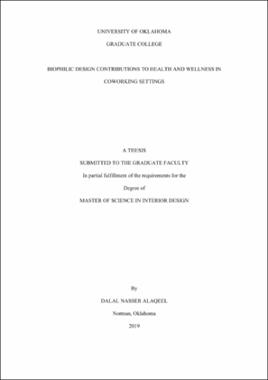| dc.description.abstract | Workplace design has evolved throughout the years, not only did the 21st century change the workspace paradigms, technological advancement and urbanization have changed where and when people work as well. There is a raised awareness on how the built environment has a significant impact on the health, wellness, and well-being of people, hence, green building practices developed as a response (United States Green Building Council, 2019). As the world’s population continues to grow, and urbanization is at its highest, with more than 66% of people living and working in urban environments, their interaction with nature lacks in the modern societies (Un-Habitat, 2012). Research on biophilic design provides evidence on nature’s ability to improve people’s health, wellbeing, and cognitive functions within the built environment (Gillis & Gatersleben, 2015; S. R. Kellert, Heerwagen, & Mador, 2011; Ryan, Browning, Clancy, Andrews, & Kallianpurkar, 2014). The biophilic hypothesis is described as the human’s innate connection to nature and natural systems (S. R. Kellert et al., 2011). Because of the world’s population that continues to urbanize, it is more important now than ever to incorporate nature into the built environment so people may benefit from the effects of being in contact with nature and natural systems (S. R. Kellert et al., 2011).
The study’s purpose is to motivate workplace designers to take further efforts in creating not only beautiful designs but to account for the health, wellness and well-being of their workers through biophilic design elements. By identifying the common biophilic synergies found in certified green building practices such as Leadership in Energy and Environmental Design certification LEED, International WELL Building Standard, and the Living Building Challenge. Second by analyzing the presence of biophilic design patterns in green building certified workplaces through case study analysis and review of literature. Finally, providing recommendations to non-biophilic workplace designs in encouragement of creating healthy, regenerative workplace designs.
This study is based on a mixed method research design, content analysis and multiple-case study method. Two green building certified workplace designs were selected in order to study their biophilic workplace considerations; The first workplace design is American Society of Interior Designers (ASID) Headquarters’ in Washington, DC. The second workplace design is Little Diversified Architectural Consulting in Charlotte, NC. The results were then compared in a cross-case study analysis with a non-green building certified co-working workplace design, WeWork co-working company, in Washington, DC. The co-working company’s concept expanded to many branches located in the United States and globally. Wework continues to propose examples of environmental concerns and wellbeing of their workers. However, through research WeWork it is shown that, the sustainable coworking business has won many design awards, however, they have yet to earn certification from any of the wellness organizations.
Aiming to support the upcoming workplaces to expand in a proficient environmentally friendly matter, but first and foremost to focus on the human health and well-being throughout their workplaces. The results of this case study will be in a series of suggestions as to what can be added to existing workplace designs to make them healthier environment’s for employees and organizations as a whole. Key sampling WeWork coworking space as an example for comparison, but further expanding to other types of workplace designs for an applicable way of incorporating biophilic design concepts for workplace health, wellness and well-being. | en_US |
